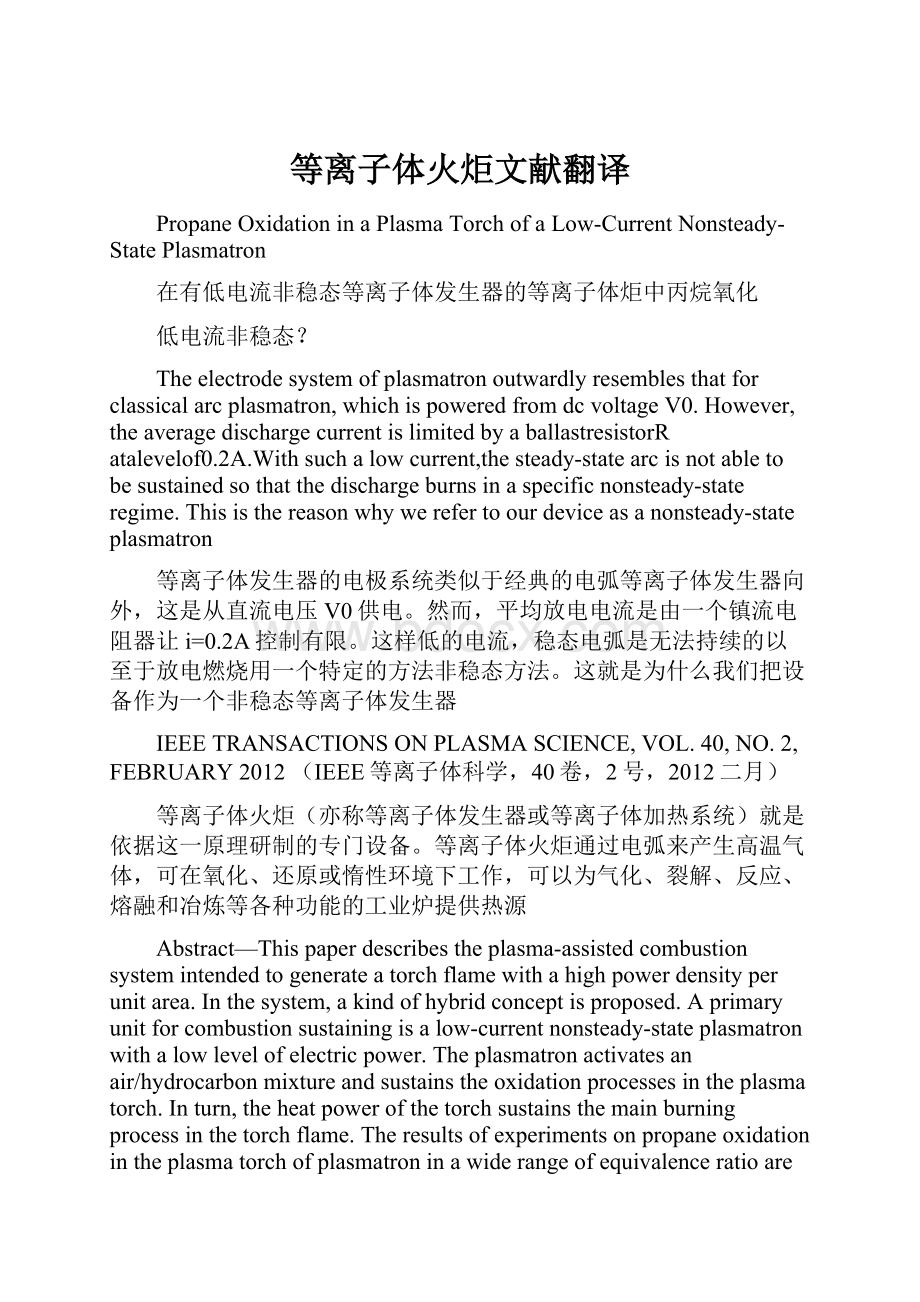等离子体火炬文献翻译.docx
《等离子体火炬文献翻译.docx》由会员分享,可在线阅读,更多相关《等离子体火炬文献翻译.docx(11页珍藏版)》请在冰豆网上搜索。

等离子体火炬文献翻译
PropaneOxidationinaPlasmaTorchofaLow-CurrentNonsteady-StatePlasmatron
在有低电流非稳态等离子体发生器的等离子体炬中丙烷氧化
低电流非稳态?
Theelectrodesystemofplasmatronoutwardlyresemblesthatforclassicalarcplasmatron,whichispoweredfromdcvoltageV0.However,theaveragedischargecurrentislimitedbyaballastresistorRatalevelof0.2A.Withsuchalowcurrent,thesteady-statearcisnotabletobesustainedsothatthedischargeburnsinaspecificnonsteady-stateregime.Thisisthereasonwhywerefertoourdeviceasanonsteady-stateplasmatron
等离子体发生器的电极系统类似于经典的电弧等离子体发生器向外,这是从直流电压V0供电。
然而,平均放电电流是由一个镇流电阻器让i=0.2A控制有限。
这样低的电流,稳态电弧是无法持续的以至于放电燃烧用一个特定的方法非稳态方法。
这就是为什么我们把设备作为一个非稳态等离子体发生器
IEEETRANSACTIONSONPLASMASCIENCE,VOL.40,NO.2,FEBRUARY2012(IEEE等离子体科学,40卷,2号,2012二月)
等离子体火炬(亦称等离子体发生器或等离子体加热系统)就是依据这一原理研制的专门设备。
等离子体火炬通过电弧来产生高温气体,可在氧化、还原或惰性环境下工作,可以为气化、裂解、反应、熔融和冶炼等各种功能的工业炉提供热源
Abstract—Thispaperdescribestheplasma-assistedcombustionsystemintendedtogenerateatorchflamewithahighpowerdensityperunitarea.Inthesystem,akindofhybridconceptisproposed.Aprimaryunitforcombustionsustainingisalow-currentnonsteady-stateplasmatronwithalowlevelofelectricpower.Theplasmatronactivatesanair/hydrocarbonmixtureandsustainstheoxidationprocessesintheplasmatorch.Inturn,theheatpowerofthetorchsustainsthemainburningprocessinthetorchflame.Theresultsofexperimentsonpropaneoxidationintheplasmatorchofplasmatroninawiderangeofequivalenceratioarepresented.Asappliedtothecombustionsystemdesign,theplasmatorchcanprovideboththecompleteandthepartialpropaneoxidationwithsyngasgeneration.
摘要:
本文介绍了等离子体辅助燃烧系统来产生每单位面积的高功率密度火炬的火焰。
在该系统中,提出了一种混合动力概念。
燃烧持续的基本单元是一个有低功率的低电流非稳态等离子体发生器。
在等离子体炬中等离子发生器激活空气/烃混合物和维持氧化进程。
相应的,火炬的热能维持在等离子体炬火焰主要燃烧过程。
在含等离子发生器的等离子炬的丙烷氧化实验结果中许多的等值比被提出。
适用于燃烧系统设计,等离子炬能让完整的和含合成气的部分丙烷氧化。
等离子体发生器:
用人工方法获得等离子体的装置
CONSIDERABLEinteresthasrecentlybeengeneratedinatmospheric-pressurelow-currentdischargesinagasflow.Asdistincttoclassicalarcdischarge,thecaseinpointistheglow-typedischargesthatproduceessentiallynonequilibriumplasmaswithalowheavy-particletemperature[1]–[4].Fundamentalinvestigationsofthesedischargesaretraditionallyfocusedonthephenomenainthestagesofeady-statedischargeformation[2],[5]–[7]andontheglow-to-sparktransitionmechanismsres:
//XDict.exe/word.html-##[8]–[13].Theatmospheric-pressureplasmasareofgrowinginterestbecauseoftheprospectsforavarietyof
相当大的兴趣,最近在一个大气压力的气体流量的低电流放电产生的。
不同于经典的电弧放电(在电源能持续提供大电流的条件下,因热电离在间隙中形成明亮、高电导、高温通道的一种强烈自持放电),在点的情况下是辉光放电(低压气体中显示辉光的气体放电(空气中的电子大概在1000对/cm,由于高压放电现象在低气压状态下会产生辉光现象)现象,即是稀薄气体中的自激导电现象)产生低重粒子(所谓重离子就是比质子重的带电粒子,通常包含带电的氦、碳及氖离子等。
如碳12、氖22、钙45、铁56、氪84和铀238等)温度的非平衡等离子体(在低气压条件下,碰撞很少,电子从电场得到的能量不容易传给重粒子,此时电子温度高于气体温度,通常称为冷等离子体或非平衡等离子体)–[1][4]。
这些放电的基础研究主要集中于在稳定状态的放电形成[2]阶段的现象,[5]–[7]和辉光火花过渡机制[8]–[13]。
大气压力等离子体越来越大的兴趣,因为有各种各样的前景
ManuscriptreceivedFebruary27,2011;revisedJuly8,2011,September28,2011,andOctober31,2011;acceptedNovember12,2011.DateofpublicationJanuary10,2012;dateofcurrentversionFebruary10,2012.ThisworkwassupportedinpartbytheInternationalScientificTechnologyCenterunderProject3959pandinpartbytheInterdisciplinaryIntegratingProjectofSiberianDivisionRASunderProjectIM-80.
手稿收到2011年2月27日;修订的2011年7月8日,2011年9月28日,2011年11月12日和2011年10月31日;接受。
出版日期2012年2月10日2012年1月10日的当前版本的日期。
这项工作是由国际科学技术中心在项目3959p和部分由跨学科整合项目在项目im-80西伯利亚分裂域。
Thesubjectofthispaperrelatestotheatmospheric-pressuredischargesasappliedtotheproblemsofignition,flamecontrol,andplasmacatalyticconversioninair–hydrocarbonmixtures[4].Differenttypesofdischargeshavebeenproposedandinvestigatedinthesystemsforplasma-assistedcombustionandflamestabilization.Amongthemmaybelistedthemicrowavedischarges[21],[22],thedielectricbarrierdischarge[23],[24],therepetitivelypulsednanoseconddischarges[25]–[27],theso-calledglidingarc[28],andeventhelasersparkwhichisinitiatedinaspaceofcombustionchamber[29]
本文的研究对象涉及大气压力排放用于点火,火焰控制的问题,和空气中的–烃类混合物[4]等离子体催化转化。
不同类型的放电已被提出并在系统研究了等离子体辅助燃烧和火焰稳定。
其中可能上市的微波放电[21],[22],介质阻挡放电[23],[24],重复脉冲纳秒放电–[25][27],所谓的滑动弧[28],甚至激光火花是在燃烧室[29]空间开始
Fig.1.
(a)Schematicarrangementoftheplasma-assistedcombustionsystemand(b)aphotographofthetorchflame.
(1)Innerelectrodeofanonsteady-stateplasmatron(cathode).
(2)Groundedouterelectrodeofplasmatron(anode).(3)Combustionchamber.(4)Pyrolysischamber.(5)Auxiliarywindows.PropaneexpenditureG=0.2g/s;airexpenditureisclosetostoichiometricblend.Heatpowerinthetorchflameisabout10kW
图1。
(一)(a)等离子体辅助燃烧系统排列示意图,(b)火炬火焰照片:
(1)非稳态等离子体发生器内电极(阴极)。
(2)接地的外电极(阳极)等离子体发生器。
(3)燃烧室。
(4)热解室。
(5)辅助窗口。
丙烷支出G=0.2克/秒;空气支出是接近化学计量的混合物。
在火炬的火焰热功率约为10千瓦
CONCLUSION
Thispaperhasdescribedtheexperimentalinstallationforplasma-assistedcombustioninair/gaseoushydrocarbonmixtures.Theinstallationisintendedtogenerateatorchflamewithahighpowerdensityperunitareaattheexitofthemaincombustionchamber.Thetorchflameisdirectedtothepyrolysischamber,inwhichreformationofthefuelswithlowcalorificvaluescanbeprovided.Inthesystem,akindofhybridconcepthasbeenproposed.Theprimaryunitforcombustionsustainingisthelow-currentnonsteady-stateplasmatronwithanelectricpoweratalevelof100–200W.Theplasmatronactivatesanair/hydrocarbonmixtureandsustainstheoxidationprocessesintheplasmatorch.Inturn,theheatpoweroftheplasmatorchsustainsthemainburningprocessinthetorchflamewithahighpowerdensity.Theresultsofexperimentsonpropaneoxidationintheplasmatorchofplasmatroninawiderangeofequivalenceratiohavealsobeenpresented.Itisdemonstratedthat,asappliedtothecombustionsystemdesign,theplasmatorchcanprovideboththecompletepropaneoxidationandthepartialpropaneoxidationwithsyngasgeneration.Oneoftheregimesofplasmatronoperationcorrespondstotheblendswithextremelyhighequivalenceratio(enhancedcontentofpropane).Inthiscase,theoxidationprocessesintheplasmatorchdonotplayanessentialrole.However,theair/fuelcompositionisactivatedintheplasmatronnozzle,andwhenanadditionalflowofairissuppliedtothemaincombustionchamber,thetorchflameissustained.
总结:
本文介绍了等离子体辅助燃烧的空气/气体烃混合物的实验装置。
安装的目的是在主燃烧室出口火炬产生一个高功率密度每单位面积的火焰。
火炬是针对热解室,其中低热值燃料的改革可以提供。
在该系统中,一种混合的概念已经提出了。
燃烧持续的基本单元是低电流非稳态态在100–200W.的等离子体发生器。
在等离子体炬中等离子体发生器激活空气/烃混合物和维持氧化过程。
反过来,等离子炬的热功率维持主燃烧过程中具有高功率密度的火炬。
广泛的当量比在含等离子发生器的等离子炬的丙烷氧化实验结果被提出。
它表明,当应用于燃烧系统设计,等离子炬能提供完整的丙烷氧化和含合成气生成部分丙烷氧化。
一个等离子发生器操作方法应对应各种具有非常高的当量比(提高丙烷完全燃烧)。
在这种情况下,在等离子体氧化过程不起着至关重要的作用。
然而,空气/燃料组合物在等离子管喷嘴被激活,当提供给主燃烧室空气流量增加,喷灯火焰持续。
Fig.2.
Schematicoftheexperimentsonmeasuringachemicalgascompositiongeneratedduetoplasmatorchoperation.(4,5,and6)Windowstoinsertaprobetubeforfluegasextraction
图2。
实验中测量由于等离子体炬操作所产生的化学气体组成示意图。
(4,5,和6)Windows废气回收探头插入管
测量的实验条件和化学组成的关系(t25时间:
气体的旅行距离x=25厘米的时间)
Fig.3.
Exampleofthevoltageandcurrentwaveformsforair–propanemixture(zerolinesforvoltageandcurrentareshownbythehorizontalarrows).TotalgasflowviaplasmatronG=0.2g/s;α=2(空气过剩系数的定义:
一般把超过理论空气量多供给的空气量称为过剩空气量,并把实际空气量Va与理论空气量Va0之比定义为空气过剩系数α在等离子体火炬和火炬火焰的燃料的氧化过程是由空气和燃料之间的比率确定。
在随后的考虑,这个比例是由所谓的空气过剩系数α按照关系α=0.065×G(空气)/g(丙烷)).VoltageofowersupplyV0=3kV;ballastresistorR=10.3kΩ.
图3。
空气–丙烷混合物的电压和电流波形的例子(电压和电流的零线如水平箭头所示)。
总的气体流通过等离子体发生器G=0.2克/秒α=2。
工作电压V0=3kV;镇流电阻R=10.3KΩ。
Fig.4.
Percentage(volume)ofthemainproductsresultingfrompropaneoxidationreducedto“dry”gasandnormalconditionsχfordifferentflowsofair.Probeislocatedatadistancex=25cm;α=1.
图4。
丙烷氧化简化的”干”气体和正常条件下不同流动气体的主要产物的百分数χ(体积)。
探针位于距离x=25厘米;α=1。
丙烷的热分解和氧化分解形成的烃类产品的百分比
浓度与气体流速的增加而增加。
T=900K−1500K
Thedistancesoftheprobetubesfromtheendoftheplasmatronnozzlearex=12.5cmandx=25cm从等离子喷嘴端部的探头管的距离x=12.5和x=25厘米厘米
Fig.5.
Percentage(volume)oftheproductsresultingfrompropaneoxidationanddecompositionreducedto“dry”gasandnormalconditionsversusthegasflow.Probeislocatedatadistancex=25cm,andα=0.5(theconditionsofsyngasgeneration).
图5。
比例(体积)的丙烷氧化分解简化为“干”的气体和正常的条件与气体流动所产生的产品。
探针位于距离x=25厘米,和α=0.5(合成气生成条件)。
Fig.6.
Percentage(volume)oftheproductsresultingfrompropaneoxidationanddecompositionreducedto“dry”gasandnormalconditionsversustheairexcesscoefficientα.G(air)=0.1g/s;x=25cm.
图6。
比例(体积)的丙烷氧化分解简化为“干”的气体和正常的条件与空气过剩系数α所导致的产品。
G(空气)=0.1克/s,x=25厘米。